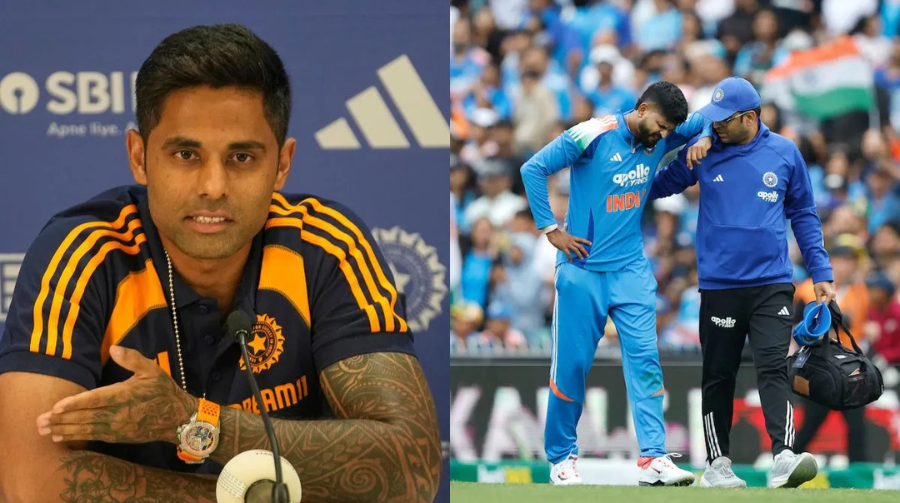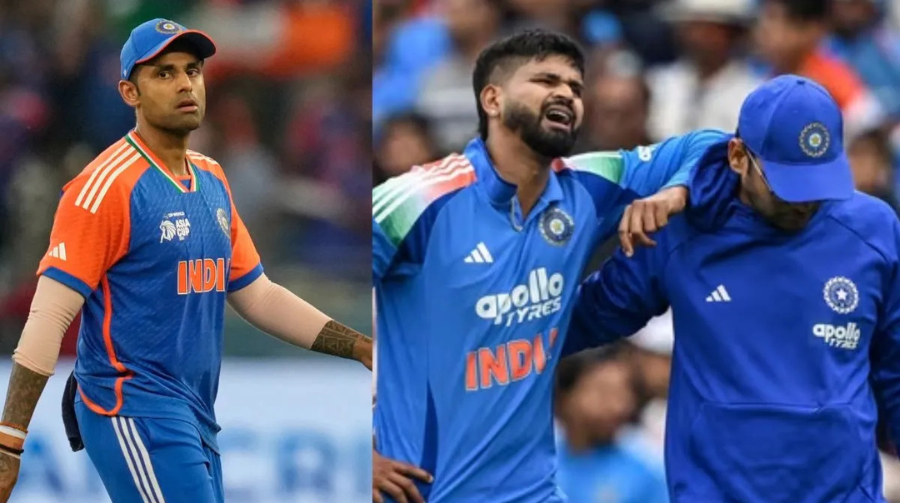Cricket
Karma Never Forgets’: Mukesh Kumar’s Mysterious Message After Being Overlooked

Team India’s pace bowler Mukesh Kumar has ignited speculation on social media after posting a cryptic Instagram story that read, “Karma bides its time. You will always have to watch out. Karma is unforgiving and always gets payback.” The message coincides with Harshit Rana’s surprise selection as the 19th member of the Test squad ahead of the series opener in England

What happened?
- On June 18, 2025, just before India departed for the first Test at Headingley, Mukesh—who was part of the India A squad and led the bowling in the first unofficial Test by taking 3/92—dropped this pointed social post
- The timing suggests he might be responding to his omission from the main squad, particularly as Harshit Rana—who took only 1/99 in the same match—was promoted

Fan & expert reactions
Many on social media interpret Mukesh’s post as a veiled message expressing frustration:
Mukesh Kumar’s frustration … He’s toiled hard, picked up around 44 wickets in his last 11 domestic games. Meanwhile, someone like Harshit Rana … gets retained … It makes you wonder what’s the point of grinding in domestic cricket
Supporters of Rana and critics of the selection process argue he was chosen for his raw pace and potential in seaming English conditions .

Player comparison at a glance
- Mukesh Kumar: 31, has earned 7 wickets in 3 Tests; showed strong form with India A, but left out of senior squad
- Harshit Rana: 23, made Test debut in Australia last year with 4 wickets; modest show in India A, yet added to the senior team as cover.

What it reflects
- Intense competition: The Test squad race is highly competitive, with players pushing from the fringes.
- Selection scrutiny: Mukesh’s post adds fuel to debates on selection bias and transparency.
- Team dynamics: Such public displays highlight emotional stakes in team composition, especially before key series.
Cricket
🇮🇳🇵🇰 India vs Pakistan Live: When and Where to Watch IND vs PAK, Hong Kong Sixes 2025 — TV, Streaming, Squad Details

Get ready for a clash of old rivals in a new format — India vs Pakistan at the Hong Kong Sixes 2025! The high-octane, fast-paced six-a-side cricket carnival is back after a break, and fans are in for some nostalgic cricketing fun at the Mission Road Ground in Kowloon.
This year’s Indian squad, led by Dinesh Karthik, will hope to change the country’s fortunes in the tournament that has historically not been their strongest suit. India won the Hong Kong Sixes only once — way back in 2005 — and will look to make a mark in this 21st edition.
🏆 Tournament Overview: Hong Kong Sixes 2025
The Hong Kong Sixes is known for its thrilling format — six players per side, five-over innings, and boundaries galore. Matches are short, explosive, and packed with entertainment.
In the 2025 edition, 12 teams are participating, divided into four groups (A–D) with three teams each.
India finds itself in Group C, alongside Pakistan and Kuwait.
Each team plays two group-stage matches, and the top two teams from each group advance to the quarter-finals.

🏏 India’s Hong Kong Sixes Record
- Champions: Once (2005)
- Runners-up: Twice
- Last appearance: 2018 (group-stage exit)
- Best performance: Won under the leadership of Rohan Gavaskar in 2005
India’s previous campaigns have often been limited by BCCI restrictions — only retired players or non-contracted cricketers can participate. However, the 2025 squad includes some well-known former Indian players, giving fans a strong reason to tune in.
💪 India vs Pakistan: Match Details
| Fixture | India vs Pakistan, Hong Kong Sixes 2025 |
|---|---|
| Match No. | 9th Match |
| Date | Friday, November 7, 2025 |
| Time | 1:05 PM IST |
| Venue | Mission Road Ground, Mong Kok, Kowloon, Hong Kong |
| Format | 5 overs per innings (Six-a-side) |
This will be India’s opening match of the tournament, while Pakistan have already begun their campaign with a win over Kuwait — putting added pressure on India to start strong.

📺 When & Where to Watch IND vs PAK Live in India
Fans in India can catch the India vs Pakistan Hong Kong Sixes live match on both TV and digital streaming platforms.
- TV Broadcast: Sony Sports 5 and Sony Sports 5 HD
- Online Streaming: Fancode app & website
- Match Timings: 1:05 PM IST (India time)
- Daily Schedule: Matches run from 5:30 AM to 3 PM IST
🇮🇳 Team India Squad for Hong Kong Sixes 2025
- Dinesh Karthik (C) – Wicketkeeper-batter, captain
- Robin Uthappa – Explosive top-order batter
- Stuart Binny – All-rounder
- Abhimanyu Mithun – Pacer with T20 experience
- Shahbaz Nadeem – Spinner and lower-order contributor
- Priyank Panchal – Reliable top-order player
- Bharat Chipli – Aggressive opening option
The mix of retired IPL and domestic veterans gives India a well-rounded unit — capable of both attacking powerplay hitting and steady control through experience.

🇵🇰 Pakistan Squad Snapshot
Pakistan enter the match with confidence after beating Kuwait. Their squad features several well-known names from the domestic circuit and former PSL players. The team is traditionally strong in shorter formats and will look to continue that momentum.
Key players include:
- Shoaib Malik (captain)
- Umar Akmal
- Anwar Ali
- Raza Hasan
⚔️ India vs Pakistan Rivalry in Hong Kong Sixes History
While not as frequent as in ODIs or T20s, IND vs PAK clashes at the Hong Kong Sixes have always drawn crowds.
- Pakistan have a slightly better record historically, winning 4 out of 6 encounters.
- India’s last win over Pakistan in this tournament came in 2009, when they chased down 88 in under 4 overs.
This edition’s match adds to that storied rivalry — with both teams packed with experienced campaigners looking to entertain.
🌟 What Makes Hong Kong Sixes Special?
- Only 5 overs per side — every ball matters.
- Bowlers bowl just one over each.
- Double runs for hitting the ball over the boundary on the bounce!
- Quick, high-scoring games perfect for new-age audiences.
It’s cricket in its most explosive, condensed, and entertaining form — and an India vs Pakistan clash guarantees fireworks.
📅 Upcoming Schedule for India (Group C)
| Date | Match | Time (IST) | Venue |
|---|---|---|---|
| Nov 7 | India vs Pakistan | 1:05 PM | Mission Road Ground |
| Nov 8 | India vs Kuwait | 11:15 AM | Mission Road Ground |
Cricket
🏏 Suryakumar Yadav Provides Heartfelt Update on Shreyas Iyer’s Injury: ‘Sath hi le jayenge usko ghar’

India’s T20I captain Suryakumar Yadav has shared a positive and emotional update on teammate Shreyas Iyer, who suffered a spleen injury during the third ODI against Australia in Sydney. Iyer, who was immediately hospitalised following the incident, has now been shifted out of the ICU and is said to be recovering steadily, easing major concerns among fans and teammates.
⚕️ What Happened to Shreyas Iyer?
The 30-year-old Indian batter sustained an internal spleen injury while taking a sharp catch to dismiss Australian batter Alex Carey during the third ODI match. The incident occurred when Iyer dived forward awkwardly, landing on his torso, after which he was seen in visible pain and rushed to a Sydney hospital.
Following medical evaluation, doctors confirmed a spleen injury, which initially required intensive monitoring in the ICU. However, after several days of treatment and observation, Iyer’s condition has improved significantly.

💬 Suryakumar Yadav’s Emotional Update
Speaking on the eve of the first T20I against Australia in Canberra, Indian skipper Suryakumar Yadav reassured fans that Iyer’s condition is improving and shared some comforting insights from his recent interactions with him.
In a light-hearted moment, Surya called Iyer a “rare talent” and humorously remarked that “rare things happen to rare people.”
🏥 Iyer’s Recovery Progress
According to BCCI sources, Shreyas Iyer’s condition has stabilized, and he has been shifted out of the ICU. Doctors have advised continued observation for a few more days before discharge.
The medical team is now closely monitoring his recovery, and initial signs suggest he may be fit to travel back to India soon for further rest and rehabilitation.

🇮🇳 Team India’s Support for Iyer
Despite not being part of the T20I squad, Iyer has remained in constant contact with teammates and the team doctor. The Indian players in Canberra have been regularly checking on his condition through video calls and messages.
The BCCI’s medical team is coordinating directly with Sydney specialists to ensure Iyer receives the best care possible. Sources close to the management confirmed that no surgery has been required so far, and doctors are optimistic about a full recovery within a few weeks.
🏏 Impact on India’s Squad Plans
While Iyer’s absence is a setback, India’s bench strength has ensured stability ahead of the five-match T20I series against Australia. The selectors are likely to rest Iyer for the upcoming South Africa tour, allowing him to recover completely before early 2026 assignments, which include home Test matches and the Asia Cup preparations.
Given his form prior to the injury — with consistent ODI runs and a strong middle-order presence — team management remains hopeful that Iyer will return before the new year.

🕊️ Fans and Cricket Fraternity Wish Speedy Recovery
Messages of support have been pouring in from across the cricketing world.
Indian cricketers Virat Kohli, Ravindra Jadeja, and Rishabh Pant shared heartfelt wishes on social media, while Australian skipper Pat Cummins also extended his prayers for Iyer’s speedy recovery.
Fans have flooded X (formerly Twitter) and Instagram with the hashtag #GetWellSoonIyer, with many sharing clips from his recent batting heroics during India’s successful ODI series against England earlier this year.
📅 What’s Next for Iyer?
If Iyer continues to recover without complications, doctors expect him to be discharged within a week and advised at least 3–4 weeks of rest before resuming light training.
Post-recovery, he will undergo a fitness assessment at the National Cricket Academy (NCA), Bengaluru, before being cleared for competitive cricket.
Meanwhile, BCCI is expected to provide an official medical update within the next few days.

📰 Summary: Shreyas Iyer’s Health Update at a Glance
| Category | Details |
|---|---|
| Injury Type | Spleen injury (during 3rd ODI vs Australia) |
| Current Status | Stable, out of ICU |
| Location | Sydney Hospital, Australia |
| Expected Discharge | Within a few days |
| Fitness Test | At NCA (after return to India) |
| Captain’s Update | “He’s talking, replying to messages, stable” — Suryakumar Yadav |
| Quote of the Day | “Sath hi le jayenge usko ghar” ❤️ |
Cricket
📰 Women’s World Cup 2025: Semifinal and Final Venues Confirmed After South Africa Beat Pakistan

The venues for the semifinal and final of the ICC Women’s ODI World Cup 2025 have been officially confirmed following South Africa’s commanding win over Pakistan in Colombo. With this result, Pakistan became the only winless team in the tournament, ending their campaign without a single victory in six games.
🏏 South Africa Outplay Pakistan in Rain-Hit Encounter
The Proteas Women defeated Pakistan Women in a rain-affected match at the R. Premadasa Stadium, Colombo, on October 21. Despite weather interruptions that reduced the game to 60 overs, South Africa displayed all-round dominance.
Batting first, South Africa posted a formidable 312/9 in 40 overs, thanks to solid half-centuries from Laura Wolvaardt, Sune Luus, and Marizanne Kapp. Nadine de Klerk added the finishing fireworks with a blistering 41 off just 16 balls, propelling the team past the 300-run mark.
In the second innings, rain again threatened to disrupt proceedings, but the Proteas managed to complete the minimum 20 overs required to constitute a result. Eventually, South Africa won by 150 runs (DLS method) — a victory that also sealed Pakistan’s elimination from the tournament.

🏟️ World Cup Semifinal and Final Venues Announced
Following Pakistan’s exit, the ICC officially confirmed the venues for the semifinal and final of the Women’s ODI World Cup 2025:
- First Semifinal: Barsapara Cricket Stadium, Guwahati
- Second Semifinal: Dr. DY Patil Sports Academy, Navi Mumbai (already confirmed earlier)
- Final: Dr. DY Patil Sports Academy, Navi Mumbai
The decision was finalized after it became clear that Pakistan would not advance to the knockout stage. Their elimination ensured there was no longer a need for neutral-venue contingency plans involving Colombo.
❓ Why the Delay in Venue Confirmation?
The ICC had initially withheld confirmation of the semifinal and final venues due to the uncertainty surrounding Pakistan’s qualification scenario.
Under a special bilateral agreement between the cricket boards of India and Pakistan, both nations’ matches in global ICC events (2024–2027 cycle) are to be played at neutral venues — a condition first introduced during planning for the Champions Trophy 2025.
Had Pakistan progressed to the knockouts, both the semifinal and final would have been held in Colombo, maintaining the neutral-ground policy. However, with Pakistan out of contention, the ICC confirmed the Indian venues without further delay.

🇿🇦 South Africa’s Campaign Back on Track
The win also bolstered South Africa’s semifinal hopes. The Proteas, led by Laura Wolvaardt, have been one of the most consistent sides in the competition. Their strong net run rate and superior middle-order performances — especially from Kapp, Luus, and de Klerk — have positioned them as serious title contenders.
With the group stage nearing its end, the semifinal line-up is expected to feature India, Australia, England, and South Africa, barring any major upsets in the remaining fixtures.
📅 Women’s World Cup 2025 Knockout Stage Schedule
- 1st Semifinal: Barsapara Cricket Stadium, Guwahati – TBA
- 2nd Semifinal: Dr. DY Patil Sports Academy, Navi Mumbai – TBA
- Final: Dr. DY Patil Sports Academy, Navi Mumbai – TBA
(Exact dates and matchups to be confirmed following the conclusion of the group stage.)
📰 Summary
- South Africa beat Pakistan by 150 runs (DLS method) in a rain-hit match.
- Pakistan officially eliminated — ending campaign winless.
- ICC confirms semifinal at Guwahati and final at Navi Mumbai.
- Neutral-venue clause no longer applicable with Pakistan’s exit.
- South Africa, India, Australia, and England likely semifinalists.
-

 Celebrity Lifestyle6 months ago
Celebrity Lifestyle6 months agoEx-Cricketer Shikhar Dhawan Buys Ultra-Luxury Apartment Worth ₹69 Crore in Gurugram
-

 Glamour & Entertainment5 months ago
Glamour & Entertainment5 months agoTelegram Channels Disseminating Pro‑Russian Propaganda in Poland
-

 Crime & Investigation3 months ago
Crime & Investigation3 months agoDelhi Police SI Neetu Bisht Caught Taking ₹20 Lakh Bribe – Shocking Details Emerge in Corruption Probe
-

 Business5 months ago
Business5 months agoAmazon sets 30‑day relocation deadline for corporate staff—opt out by resigning in 60 days
-

 Celebrity Lifestyle5 months ago
Celebrity Lifestyle5 months agoMaha Kumbh Girl Monalisa seen in car allegedly worth ₹1 crore
-

 Entertainment5 months ago
Entertainment5 months agoAbhijeet & Dr Tarika Reunite in CID 2 — Fans Say ‘Clear the Misunderstanding Now
-

 Education5 months ago
Education5 months agoNEET UG Controversy Explained: Paper Leak, Impersonations & Ongoing Probe
-

 Bollywood3 months ago
Bollywood3 months agoNo ₹3 Lakh Fine or 2-Year Jail: The Truth Behind the ‘Hakla’ GIF Buzz




